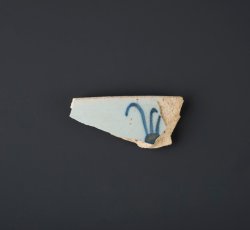Body, Rim - Page 11 of 12

Staffordshire slipware dotted cup or drinking pot.
Coarse Earthenware | Object #: 1722451
This fragment is a ceramic archaeologists refer to as North Midlands/Staffordshire type slipware. The word “type” is used here to denote the fact that coarse, slip decorated wares were actually produced in several regions of England throughout the seventeenth and eighteenth century. One feature...
Explore This Item
Jackfield-type holloware rim.
Refined Earthenware | Object #: 1722532
Slightly everted rim. Possible teabowl or cup.
Explore This Item
Handpainted blue tin-glaze earthenware plate or dish.
Refined Earthenware | Object #: 1722601
This is a fragment of a tin-glazed earthenware dish or plate. This ware is often referred to by archaeologists as delftware. The white coloration of the glaze was obtained by adding tin-oxide to a lead glaze. Against this white field, delft was most often decorated with hand painted cobalt blue...
Explore This Item
Handpainted blue tin-glaze earthenware teaware, unidentifiable.
Refined Earthenware | Object #: 1722744
Possible saucer.
Explore This Item
Handpainted blue tin-glaze earthenware bowl.
Refined Earthenware | Object #: 1722749
This is a fragment of a tin-glazed earthenware bowl, or possibly small punch bowl, with a hand painted decorative band adorning the rim. This ware is often referred to by archaeologists as delftware. The white coloration of the glaze was obtained by adding tin-oxide to a lead glaze. Against thi...
Explore This Item
Creamware teabowl.
Refined Earthenware | Object #: 1723068
This fragment of cream colored ceramic is a portion of teabowl. Archaeologists refer to this kind of ceramic as creamware and associate it with that produced by English potter Josiah Wedgewood beginning in 1762. Wedgewood successfully marketed this ware to a wide range of consumers. In 1767, he...
Explore This Item
Creamware teaware, possible large teabowl or slop bowl.
Refined Earthenware | Object #: 1723073
This fragment of cream colored ceramic is a portion of hollow teaware, possibly a large teabowl or a slop bowl. Archaeologists refer to this kind of ceramic as creamware and associate it with that produced by English potter Josiah Wedgewood beginning in 1762. Wedgewood successfully marketed thi...
Explore This Item
Feather-edge creamware plate or dish.
Refined Earthenware | Object #: 1723101
This fragment of cream colored ceramic is a portion of a plate or platter decorated with a feather edged pattern along the rim. Archaeologists refer to this kind of ceramic as creamware and associate it with that produced by English potter Josiah Wedgewood beginning in 1762. Wedgewood successfu...
Explore This Item
Feather-edge creamware plate or dish.
Refined Earthenware | Object #: 1723118
This fragment of cream colored ceramic is a portion of a plate or platter decorated with a feather edged pattern along the rim. Archaeologists refer to this kind of ceramic as creamware and associate it with that produced by English potter Josiah Wedgewood beginning in 1762. Wedgewood successfu...
Explore This Item
Feather-edge creamware plate or dish.
Refined Earthenware | Object #: 1723120
This fragment of cream colored ceramic is a portion of a plate or platter decorated with a feather edged pattern along the rim. Archaeologists refer to this kind of ceramic as creamware and associate it with that produced by English potter Josiah Wedgewood beginning in 1762. Wedgewood successfu...
Explore This Item
Feather-edge creamware plate or dish.
Refined Earthenware | Object #: 1723124
This fragment of cream colored ceramic is a portion of a plate or platter decorated with a feather edged pattern along the rim. Archaeologists refer to this kind of ceramic as creamware and associate it with that produced by English potter Josiah Wedgewood beginning in 1762. Wedgewood successfu...
Explore This Item
Westerwald/Rhenish 2-quart "GR" stoneware jug.
Stoneware | Object #: 1725014
This is a fragment of a stoneware jug produced in the Westerwald region of Germany. German stonewares played an important part of the English and colonial ceramic market of the eighteenth century. These vessels were available in a variety of forms but most commonly as jugs, mugs and chamberpots...
Explore This Item
White salt glaze stoneware teabowl.
Stoneware | Object #: 1725435
This is a fragment of a white salt glazed stoneware teabowl. This white bodied ceramic was produced by combining naturally white clays with ground and calcined flint. Undecorated teaware forms such as this item were generally popular between the first and last quarter of the eighteenth century,...
Explore This Item
White salt glaze stoneware teabowl.
Stoneware | Object #: 1725573
This is a fragment of a white salt glazed stoneware teabowl. This white bodied ceramic was produced by combining naturally white clays with ground and calcined flint. Undecorated teaware forms such as this item were generally popular between the first and last quarter of the eighteenth century,...
Explore This Item
White salt glaze stoneware vessel.
Stoneware | Object #: 1725579
Thin-walled vessel with very flared rim and little curvature. Likely from vessel with irregular rim form.
Explore This Item
White salt glaze stoneware dot, diaper, and basket molded plate.
Stoneware | Object #: 1725686
This slightly burned fragment of white salt glazed stoneware is a portion of a plate rim decorated by press molding. This white bodied ceramic was produced by combining naturally white clays with ground and calcined flint. In the process of press molding, clay sheets were pressed into block mol...
Explore This Item
White salt glaze stoneware molded 'barley rim' plate or dish with scalloped edge.
Stoneware | Object #: 1725846
This lightly burned fragment of white salt glazed stoneware is a portion of a plate rim decorated by press molding. This white bodied ceramic was produced by combining naturally white clays with ground and calcined flint. In the process of press molding, clay sheets were pressed into block mold...
Explore This Item
White salt glaze stoneware molded 'barley rim' plate or dish.
Stoneware | Object #: 1725984
This fragment of white salt glazed stoneware is a portion of a plate rim decorated by press molding. This white bodied ceramic was produced by combining naturally white clays with ground and calcined flint. In the process of press molding, clay sheets were pressed into block molds to form both ...
Explore This Item
White salt glaze stoneware dot, diaper, and basket molded plate or dish with scalloped edge.
Stoneware | Object #: 1725991
This fragment of white salt glazed stoneware is a portion of a plate rim decorated by press molding. This white bodied ceramic was produced by combining naturally white clays with ground and calcined flint. In the process of press molding, clay sheets were pressed into block molds to form both ...
Explore This Item
White salt glaze stoneware dot, diaper, and basket molded plate.
Stoneware | Object #: 1726025
This fragment of white salt glazed stoneware is a portion of a plate rim decorated by press molding. This white bodied ceramic was produced by combining naturally white clays with ground and calcined flint. In the process of press molding, clay sheets were pressed into block molds to form both ...
Explore This Item